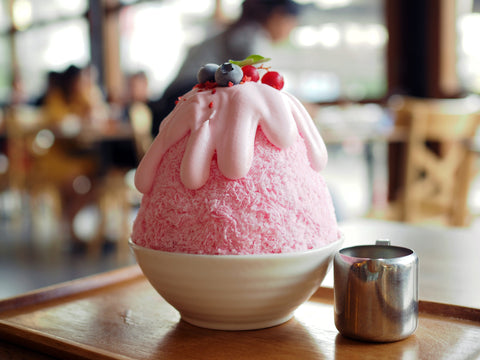What Is Kakigori?
Ah, kakigori, Japanese shaved ice of many colors. So, what is it, exactly? In a nutshell: a little mountain of fine shavings light as fresh snow, flavored with syrup, and sweetened with condensed milk. In the summer, cuisines the world over serve their own versions of kakigori. Read on and compare Japanese shaved ice with your beloved local dish; ideally, you’ll be able to try both in-person, too. Since kakigori touched down in the United States in the late 2010s, American foodies have been eating their way through drifts of Japanese shaved ice with glee. But this newcomer to the Western hemisphere is just kakigori’s latest polar vortex. The Shaved Ice Age has been going on for centuries.

One thousand years ago, a lady-in-waiting named Sei Shonagon wrote in her seminal text The Pillow Book some short notes on “Refined and Elegant Things.” Included in that list is the world’s first written mention of kakigori: “shaved ice mixed with liana syrup and put in a new silver bowl.” A refined and elegant thing, indeed! The true kakigori origin story is undocumented, but at the time Shonagon was writing, and for many centuries to follow, Japanese shaved ice was an extravagance. Long before railways would quickly transport perishable goods, long before electric refrigeration, the making of the summertime sweet would begin when winter temperatures dropped below freezing. Blocks of naturally-formed ice were extracted from their water sources and transported to courtly ice-chambers. There, the ice would wait until the summer months for optimal enjoyment. Please note: several months in, the ice is still a raw ingredient.
Once home refrigeration became commonplace, it became quite ordinary to see kakigori machines within the home. Though few families are making their own today, kakigori is everywhere in the summer, from specialty shops and stands at festivals to convenience stores, restaurants, and even the odd neighborhood garage. Depending on where you find it, true Japanese shaved ice prizes texture (think fresh-fallen snow) and flavor. The sweet, mild stems and leaves of the liana may have produced sweet satisfaction in the 1000s, but about seven hundred years later, the Japanese palate was beginning to change, thanks to the import of “European” sugar.
Of all the different flavors kakigori purveyors offer today, beloved standbys are typically either fruit-based or involve ingredients like matcha syrup or sweet red beans. Condensed milk gives the dish a silky richness, its thickness offset by quickly-melting ice. Among Japanese, flavors from expensive imported fruits like mangos fetch a higher rate. International tourists visiting temples in the Kyoto area, however, will find large and elaborate concoctions with ingredients typical of more traditional Japanese sweets. Take the city of Uji for example, the birthplace of matcha, thanks to some ingenious agricultural developments many years ago. Here, the summer visitor can choose between meal-sized variations of kakigori, like a deliciously dark-green variety flavored with matcha syrup and condensed milk, topped with anko (sweet red bean), eye-catching hard jellies, and even some small mochi! It’s not a dish easily recreated abroad. But fear not, homebound reader: it’s also not the be-all and end-all of Japanese shaved ice.
For anyone without summer travel plans to hot, humid Japan, you’re in luck! In cities across the United States, the kakigurious have plenty of options. (You’re welcome for the portmanteau, by the way.) Hawaii has its own robust and long-standing kakigori traditions thanks to a large Japanese population. In recent years, kakigori has crossed over to the continental US, too. Here the intrepid diner can find innovative takes on Japanese shaved ice. The texture of the ice remains non-negotiable. It must be shaved perfectly: not so fine that it will deflate or melt too quickly, but not so thick that it will harden as it melts. Chefs have begun experimenting with flavors, toppings, and local ingredients instead. In doing so, they can prolong Cold Sweets Summer. They also join a long tradition of kakigori “cooks” riffing on a dish so flexible and universally loved as to have remained on the menu for over a millennium.
Author Bio











